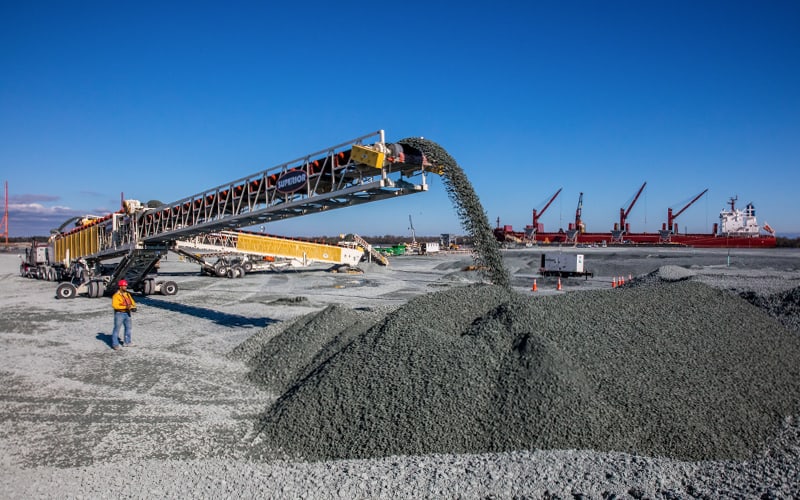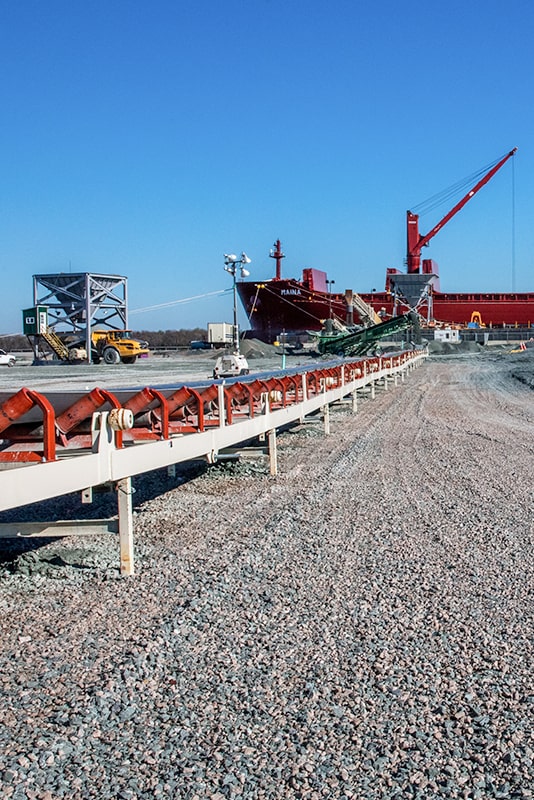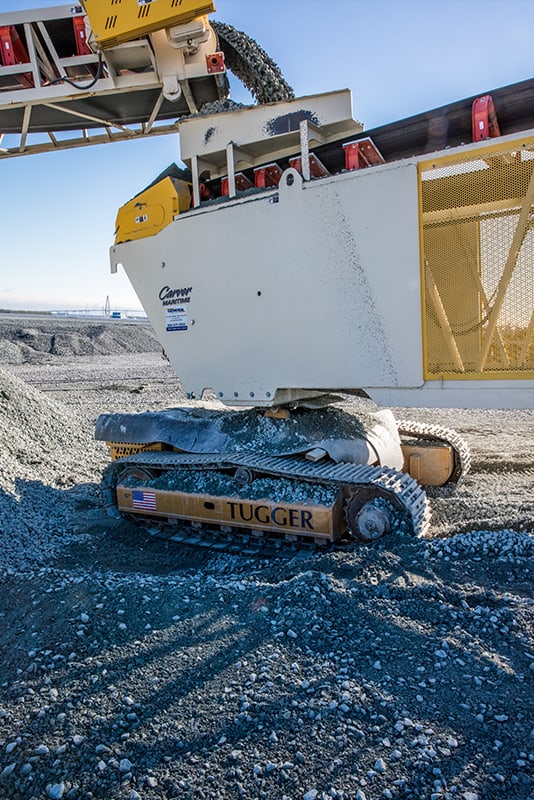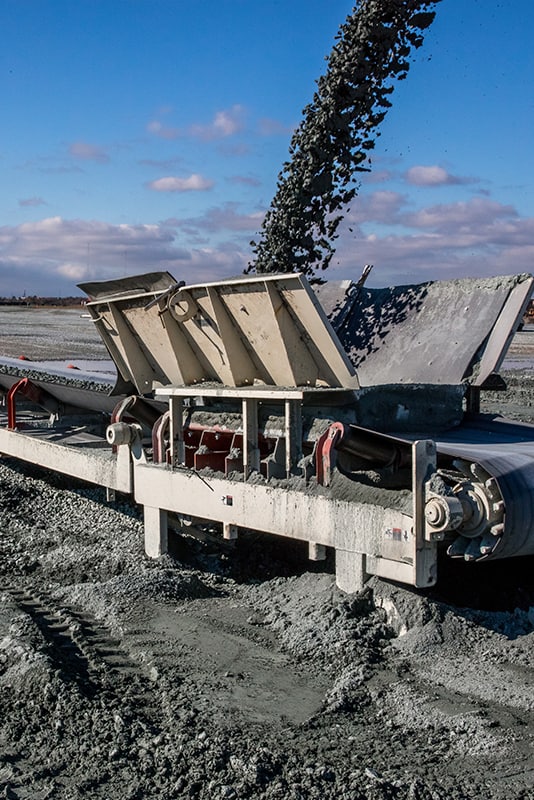Ship to Shore
Highly-Mobile Conveyor Technology Unloads & Distributes Multi-Million-Ton Aggregate Shipment for Terminal Project
The South Carolina Ports Authority (SPA) is deep into construction of the only permitted new container terminal on the U.S. East and Gulf Coasts – the Hugh K. Leatherman Sr. Terminal which is targeted to open in 2019. Citing the project as its largest capital improvement initiative to date, the SPA says its goal is better accommodating the bigger container ships traveling through the newly-expanded Panama Canal. The facility will ultimately handle up to 1.4 million cargo boxes annually, which boosts the SPA’s current containerized cargo capacity by more than 50-percent.
Construction on the 280-acre site is designed for substantial mitigation of community and environmental impacts. Notably, the SPA wanted to avoid the emissions, dust, noise and congestion of bringing in nearly 4-million-tons of aggregate fill material via trucks. Instead, 70,000 tons of crushed stone is shipped each week on a rotating series of barges from a quarry in Newfoundland. Carver Companies, an East Coast marine offload specialist, handles the unloading of the aggregate from the vessels; while also conveying the material, and placing it in short lifts within a large containment area. When filled, that area will be paved and used to store incoming and outgoing cargo containers.
“We’ve made big investments in highly-mobile loading and unloading conveying systems, so that we can custom-configure offloading services to meet the needs of any project,” says Carver Companies President Carver Laraway. “We operate flexible, versatile equipment designed to handle a variety of vessels, and a variety of materials,” he says, adding that he accesses equipment manufactured by Minnesota-based Superior Industries, a company that has long been a leading supplier of mobile conveying technology. Versus costly stationary ship loading/unloading systems, mobile conveying systems offer lower operating costs, quick assembly, efficiency within a small footprint, and ease of relocation.
Project Details
COMPANY
Carver Companies
LOCATION
Charleston, South Carolina
APPLICATION
Terminal: Ocean
PRODUCT(S)
TeleStacker® Conveyor
Trailblazer® Conveyor
Zipline® Conveyor
Summary
The South Carolina Ports Authority constructed a container terminal on the U.S. East and Gulf Coast – The Hugh K. Leatherman Sr. Terminal which will handle up to 1.4 million cargo boxes annually. Offloading at a rate of 1000- to 1300-tons-per-hour, Carver Companies is “transloading” the aggregate material from the incoming ship to a 105-ft x 440-ft stationary barge that’s outfitted with four hoppers. Under each hopper is a 42-inch x 360-ft Superior Zipline Conveyor. Running parallel to the barge, the Zipline conveyors feed an onshore 42-inch x 150-ft TeleStacker Conveyor, a multi-functional telescopic radial stacking unit that can load, unload, and stockpile.
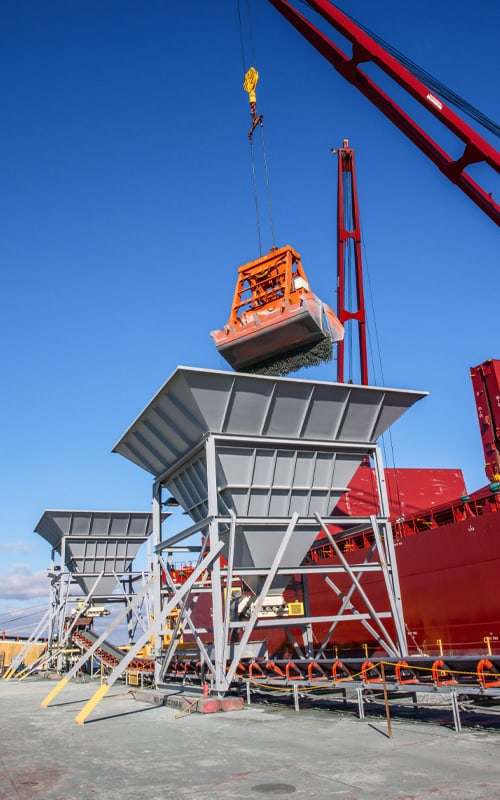
offloading system specs
To design the system, Laraway worked closely with Jerry Kern, the aggregate sales consultant for General Equipment, a dealer for Superior Industries. Operating offices in North Dakota and Minnesota, General Equipment maintains a large inventory of equipment for rental and sales; and they had worked with Carver Companies on a previous ship unloading project. Laraway says that Kern was instrumental in the layout and design of the system. Also, Laraway stresses that General Equipment had the units in stock and could deliver as requested. After all the equipment was delivered to the site, assembly of the system took just about a week. “I’m big on buying American-made equipment and the Superior equipment is top-notch. Plus, the support that Jerry Kern gave us was an extreme blessing,” he says.
Offloading at a rate of 1000- to 1300-tons-per-hour, Carver Companies is “transloading” the aggregate material from the incoming ship to a 105-ft x 440-ft stationary barge that’s outfitted with four hoppers. “It takes an average of 80 hours to unload one ship, and about 14 months to complete the entire offload project,” says Laraway. Cranes with 20-ton clam buckets load material into the hoppers. Under each hopper is a 42-inch x 360-ft Superior Zipline Conveyor, which is a pre-engineered, modular overland conveyor that’s designed for quick, tool-less installations; and ease of relocation.
Superior Industries engineers say that when compared to conventional “spec-by-spec” highly engineered overland systems, the Zipline conveyor is a lower-cost alternative designed with off-the-shelf components for easy replacement of idlers and pulleys. The system also features a modular design that allows for easy structural additions or deletions when required.
A belt feeder on each hopper regulates the feed to each Zipline conveyor at 350 tons-per-hour. Running parallel to the barge, the Zipline conveyors feed an onshore 42-inch x 150-ft TeleStacker Conveyor, a multi-functional telescopic radial stacking unit that can load, unload, and stockpile. Importantly, the unit allows operators to maintain material specifications from the ship to the stockpile. According to Superior, the TeleStacker conveyor achieves 45-percent more extension over that of conventional conveyors; and it’s designed to move inline, transversely, and radially for fast, efficient movement within the footprint.
From the telescopic radial stacker, material is transferred to the containment area by a Superior Trailblazer Conveyor, a 500-ft preassembled portable groundline system that transports from site to site in one 84-ft towable load; and allows rapid deployment from the road to working status in about an hour. With a gravity-style take-up built into the trailer structure, the Trailblazer conveyor simply folds in or out in an accordion-fashion from its chassis, with a small crew required to position the supports. Beyond this groundline system, Carver Companies uses a series of portable jump conveyors to transfer material where needed in the containment area. The portability of these conveyors allows the crew to shift units in and out of the lineup as required.
Within the 2000-ft x 2000-ft containment area, Carver Companies uses two additional 42-in x 150-ft TeleStacker conveyors to properly distribute the material, readying the site for future paving. As the project requires placing material in short 4-ft to 5-ft desegregated lifts, the stackers are constantly moving about the site. The FD axle setups on the stackers allow for easy movement and rotation. Additionally, General Equipment assisted Carver Companies in acquiring two used track-mounted “tuggers” to aid in safely moving the stackers where needed over terrain that may not always be level or firm.
poised for growth
In past years, Laraway says he had always been concerned about the costs of the multiple handling of material. “Trucks would come to the dock and dump the aggregate material on the ground. A loader and an operator would push up the piles, while a material handler and an operator would scoop it up and load it on the barge. That is hardly efficient,” he stresses. “Today, we can relocate our systems wherever they are needed. Once our mobile conveying system is configured to meet project specifications, the operator flips a switch and it’s up and running. That’s a big advantage over the labor, overtime, and fuel associated with using wheel loaders to move material,” says Laraway.
Currently, Carver Companies has three offloading operations moving material along the East Coast – and Laraway says that his company is “poised for further growth because we have the right mobile conveying equipment.”
Have questions? Need more information? Complete the form below and we will follow up shortly.
Request More Info
See our privacy policy.

